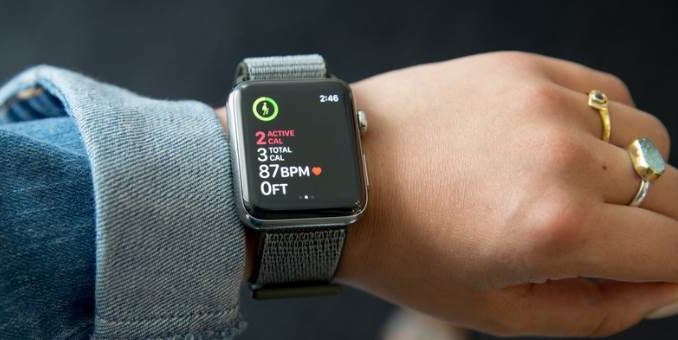
Apple announced last week that its Apple Watch Series 4 (available today on apple.com) would have some serious heart-health features. The wearable will allow users (later this year) to take an electrocardiogram, also known as an ECG or EKG, to measure heart rhythms; results can be sent as a PDF to a doctor. An advanced built-in heart rate sensor will be able to detect atrial fibrillation (irregular heart rate), which can increase risk of stroke. The sensor can also detect and notify you of a low heart rate as well as fast heart rate.
Evolving the watch from fitness tool to health device “wasn’t the original intent,” says Apple COO Jeff Williams. “The reality is, we put the heart rate sensor on the watch initially just to calculate calorie burn, and then this move towards helping people discover heart issues really happened organically.”
With the wearables market growing and Apple selling more than any other brand, the announcement about the new health features was cheered by some and questioned by others. Should low-risk patients have the ability to self-test? Won’t hypochondriacs have a field day? Will this lead to false positives and unnecessary treatment and testing? Maybe. But big picture, providing people—women in particular—with more information about their bodies is empowering and may spur awareness and conversations that could be life-changing, even life-saving.
Heart disease is still often seen as a man’s disease, when in fact it’s the number one killer of women, says Roshini Rajapaksa, MD (“Dr. Raj”), Health’s medical editor and associate professor of medicine at the NYU School of Medicine. And young (under 55) women who report heart attack symptoms are more likely to have them dismissed as something else, according to one recent Yale study. Another study showed that when some patients are having symptoms, they wait to seek help for fear of initiating a false alarm. Part of the problem may be that women experience symptoms beyond the expected chest pain, such as indigestion and jaw pain.
Further, research also shows that female primary care doctors spend more time with their patients, and that heart patients admitted to emergency rooms have lower mortality rates if treated by a female doctor.
All of this seems to point to the need for better education and communication between patient and doctor. That’s where the power of information comes in. A woman tracking her heart rate as she works out may be more in tune with her body and think to ask questions she might not otherwise, leading to valuable learning. And an ECG taken in 30 seconds on a watch gives her something concrete to lead with in a discussion with a doctor, especially important if she feels intimidated or the appointment is rushed.
It also provides the doctor with a fuller picture. “When I see a patient, I’m only seeing a very small snapshot of what’s going on in that 15 or 30 minutes,” says Dr. Raj. “So even if I do a blood pressure measurement or an EKG, it’s just capturing that moment in time. The ability here to track things like heart rate or irregular rhythms more consistently provides more complete information about what’s going on in someone’s body, both for the patient and for the doctor.”
“We don’t view anything that we’re doing as replacing the physician,” agrees Williams. “We view that it helps them operate at the top of their license because they have much richer information.”
Apple plans to keep going in this direction. “Our goal is to move as fast as possible across the curve where people are taking a more active role in their health,” says the COO.
To that end, it’s not just the newest features that can help women be proactive in taking care of themselves. And you don’t need the latest Apple Watch to use tech to your advantage. Tracking steps, logging foods, monitoring reproductive cycles, meditating, and much more are all things that can be done with the help of a less-advanced fitness tracker or smartwatch. And when it comes to your health, “really getting down to basics is most important,” says Dr. Raj. “Eating the right foods, exercising, getting enough sleep, and managing your stress.”
Source:-Health.com

Leave a Reply